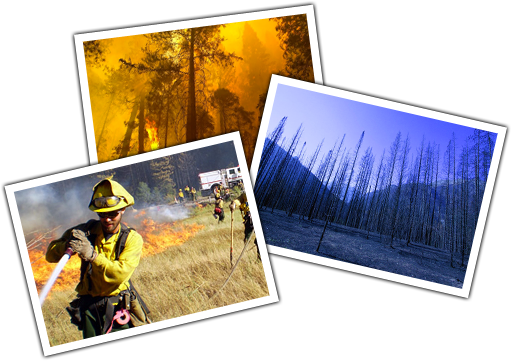WILDFIRE Magazine Article
 Brand Dilution (Cover article); Wildfire Magazine; Mar. 2005
Brand Dilution (Cover article); Wildfire Magazine; Mar. 2005
by Joseph W. Mitchell
Here are some references behind the article
WEEDS: Firebrand Defense for the “Typical Catastrophe”
The ideas underlying the WEEDS concept, the proposition that firebrands are responsible for a preponderance of home ignitions, and other concepts put forward in this article come from a number of sources. For those interested in further research, here they are.
Structure Losses:
Statistics from the National Interagency Fire Council for structure losses in the United States due to wildland fire: 1999 - 817 structures, 2000: 861 structures, 2001 – 731 structures, 2002 - 2381 structures (835 homes)
Self-Organized Critical Phenonmena:
A great explanation of self-organized critical phenomena is given in a book by the late Per Bak, one of the original founders of this field of research:
Bak, Per - How Nature Works: the science of self-organized criticality; Copernicus; 1996
Experimental verification that this theory is applicable to wildland fire was most recently published in the following:
Malamud, B. D., G. Morein, and D. L. Turcotte (1998), Forest fires: An example of self-organized critical behavior, Science, 281, 1840- 1842
Firebrands and Structure Ignition:
Several forensic studies conducted by Australian fire experts revealed that firebrands are the primary cause of structure ignition during wildland fire. The most recent of these was based upon satellite measurements and was published in 2004.
Ramsay, G.C., McArthur, N.A. & Dowling, V.P.; Preliminary results from an examination of house survival in the 16 February 1983 bushfires in Australia. Fire and Materials, 11 (1987) 49.
Dowling, V.P.; 1994;Ignition of Timber Bridges in Bushfires; Fire Safety Journal; v. 22; pp. 145-168
Ramsay, G. C., et. al; "Building in a fire-prone environment: research on building survival in two major bushfires"; Proc. Linn. Soc. N.S.W; 116; 133-140
Chen, Keping and John McAneney; Geophys. Res. Lett. 31; L12212; 2004
In the United States, USFS Scientist Jack Cohen has raised the firebrand threat issue in a number of his publications and videos. A list of these (http://www.firelab.org/fbp/fbresearch/wui/pubs.htm) can be found at the Wildland-Urban Interface Research Project site of the Missoula Fire lab.
The Australian Way:
Some Australian fire authorities encourage people to stay with their structures and protect them, as described in last year's Wildfire article by Assistant Commissioner Keith Harrap of the New South Wales fire protection agency:
Asst. Commissioner Harrap, Keith; NSW Rural Fire Service; Shelter Shock; Wildfire; Jan/Feb 2004; p. 18
A self-help book by a woman who has devoted most of her life to wildland fire safety describes how to do this:
Webster, Joan; The complete bushfire safety handbook; Random House Australia; Sydney; 2000
The Ramona Municipal Water District Hearings:
The testimony of 50 citizens affected by the Cedar fire was heard by the political body responsible for fire protection in Ramona, California. The audio tapes have been transcribed, and are available on the website of the Mussey Grade Road Alliance, a local activist group.
Ramona Municipal Water District Cedar Fire Hearings, January 2004; http://www.musseygraderoad.org/CedarFire/CedarIndex.htm; also available in original audio format from the Ramona Municipal Water District, 105 Earlham Rd., P.O. Box 1829, Ramona, CA 92065
Wildland Fire Protection Codes:
Current best practices of the fire protection services can be found in:
National Fire Protection Association, NFPA 1144 Standard for Protection of Life and Property from Wildfire, 2002 Edition, Quincy, MA.
International Code Council, Inc., 2003 International Urban-Wildland Interface Code; ISBN 1-892395-70-3 (soft); ISBN 1-892395-88-6 (e-document); 2003
External Sprinkler Systems:
A comparison of various designs can be found in
Fire Protection Association of Australia; Field Study: External Water Spray Systems to Aid Building Protection from Wildfire; Ref: 100-0346; 10 June 2000
Two articles give excellent summaries of the experimental crib data which measure the water spray density levels capable of extinguishing fire:. Novozhilov, V., et al.; Solid fire extinguishment by a water spray; Fire Safety Journal 32; (1999) 119–135
Grant, G., J. Brenton, and D. Drysdale; 2000; Fire suppression by water sprays; Progress in Energy and Combustion Science; v26; pp. 79-130

